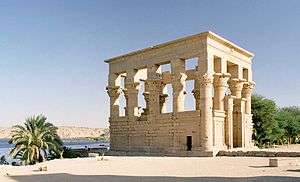Hypaethral

Philae, Trajan's Kiosk, Aswan, Egypt, Oct 2004

The Hypaethral Temple of Philae, a romantic depiction by David Roberts painted in 1838
Hypaethral is an ancient temple with no roof. (From the Latin hypaethrus, from Ancient Greek ὕπαιθρος hupaithros ὑπό hupo- "under" and αἰθήρ aither "sky, air".) It has instead a hypaethros or hypaethral opening. It was described by the Roman architect Vitruvius in his treatise On Architecture written for the emperor Caesar Augustus probably about 15 BC. This term is in distinction from cleithral, which is covered with a roof.[1]
Examples
- Trajan's Kiosk (shown above right) on the island of Philae near Aswan, Egypt.
- The Ranipur-Jharial archeological site in Balangir District in the Indian state of Orissa.
- Temple of Apollo at Didyma, at Didim, Turkey
- Chausathi Jogini Temple, at Odisha, India
References
- ↑ Hypaethral and Roofless Structures. DrBillong.com. Accessed June 10, 2012.
External links
This article is issued from Wikipedia - version of the Thursday, July 09, 2015. The text is available under the Creative Commons Attribution/Share Alike but additional terms may apply for the media files.